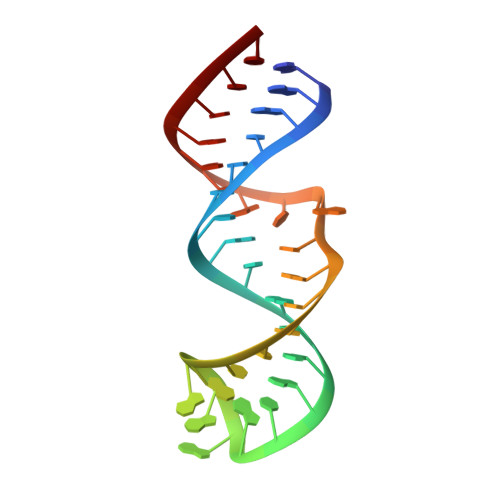Molecular dynamics re-refinement of two different small RNA loop structures using the original NMR data suggest a common structure.
Henriksen, N.M., Davis, D.R., Cheatham Iii, T.E.(2012) J Biomol NMR 53: 321-339
- PubMed: 22714631
- DOI: https://doi.org/10.1007/s10858-012-9642-5
- Primary Citation of Related Structures:
2LPS, 2LPT - PubMed Abstract:
Restrained molecular dynamics simulations are a robust, though perhaps underused, tool for the end-stage refinement of biomolecular structures. We demonstrate their utility-using modern simulation protocols, optimized force fields, and inclusion of explicit solvent and mobile counterions-by re-investigating the solution structures of two RNA hairpins that had previously been refined using conventional techniques. The structures, both domain 5 group II intron ribozymes from yeast ai5γ and Pylaiella littoralis, share a nearly identical primary sequence yet the published 3D structures appear quite different. Relatively long restrained MD simulations using the original NMR restraint data identified the presence of a small set of violated distance restraints in one structure and a possibly incorrect trapped bulge nucleotide conformation in the other structure. The removal of problematic distance restraints and the addition of a heating step yielded representative ensembles with very similar 3D structures and much lower pairwise RMSD values. Analysis of ion density during the restrained simulations helped to explain chemical shift perturbation data published previously. These results suggest that restrained MD simulations, with proper caution, can be used to "update" older structures or aid in the refinement of new structures that lack sufficient experimental data to produce a high quality result. Notable cautions include the need for sufficient sampling, awareness of potential force field bias (such as small angle deviations with the current AMBER force fields), and a proper balance between the various restraint weights.
- Department of Medicinal Chemistry, College of Pharmacy, University of Utah, 2000 East 30 South Skaggs 201, Salt Lake City, UT 84112, USA. tec3@utah.edu
Organizational Affiliation:
















